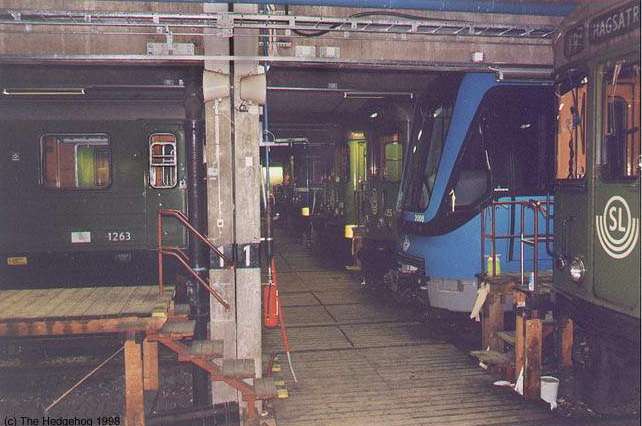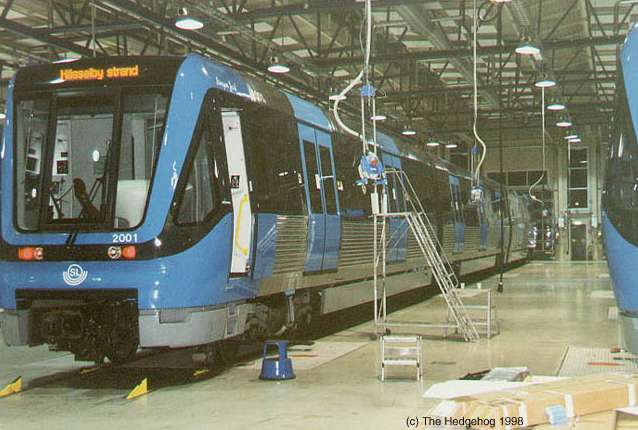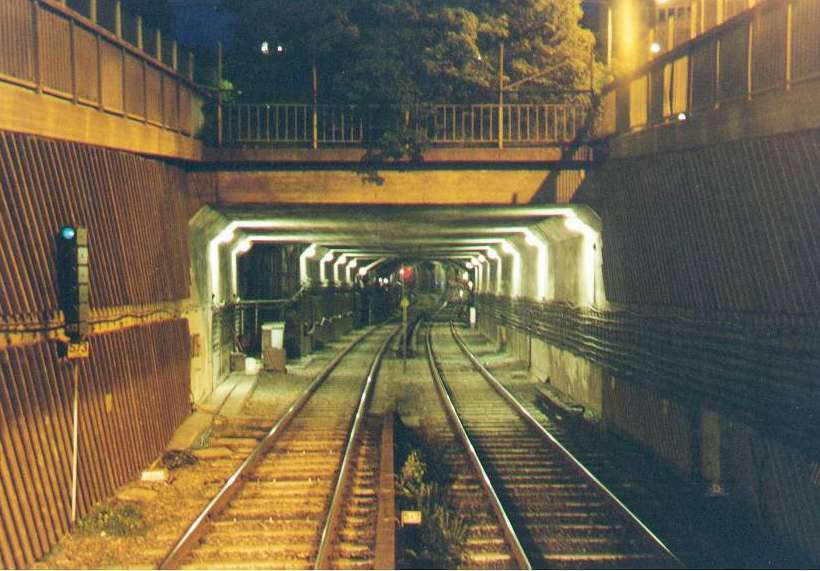|
Life Underground Overseas
Many large cities
overseas have metros like the London Underground. Here are some stories, facts,
rumours and pictures from other metros. Contribution from overseas are
welcome. Please contact Tubeprune here.
Contents
Moscow
Metro Facts - Ice in Stockholm - It's a Dog's Life - Stockholm
Tunnel
Link to the Toronto Subway
Here are some facts about the
Moscow Metro, kindly translated and supplied by Dimitri Litovchenko.
Route kilometres: 268
Stations: 163
Power rail voltage: 850 V
Total cars: 4150
Maximum train frequency: 45 train pairs per hour
Maximum rolling stock speed 90 km/h
Average service speed 41 km/h
Longest line: Serpukhovsko-Timiryazevskaya line, 41 km. between "Altufyevo" and
"Annino"
Longest tunnel: the same
Longest single journey on 1 train: the same. "Koltsevaya"(Circular)
line doesn't count.
Shortest line: "Kakhovskaya", 4 km. between "Kashirskaya" and
"Kakhovskaya"
Longest distance between 2 stations: 3.5 km. between "Tekstilschiki" and
"Volgogradsky Prospect"
Shortest distance between 2 stations: 460 m. between "Aleksandrovsky Sad" and
"Arbatskaya"
Deepest station: "Dubrovka", Lyublinskaya line, opened December 11, 1999, 62 m.
deep
Total passenger journeys/day: average 9 000 000
max. - more than 12 000 000 at September 5, 1997
Last train: Departs at 01:03 from each terminal station.
By "Hedgehog", a
train operator on the Stockholm Metro, 8 March 2002.
This new year in Stockholm we
had a spell of intense cold (-28ºC) with a heavy snowfall which crippled the line I work
on, Line 1, the "green line". The oldest parts of the line date from the
1930s. About 35% of it is in tunnel, the rest in the open. It's sort of
Metropolitan Line-ish. For several days, traffic was an absolute mess, with trains
cancelled, lines closed and all sorts of signalling and points failures, as well as
equipment failures on the trains.
One problem was ice forming in
the air pipes of the trains. While we did not have any train that suffered a brake
failure due to icing, there was no train of those few running that did not have several
leaks, hissing loudly from valves that didn't close properly. On the old trains, the
doors are air-operated and we had several trains that went into emergency brake when the
driver stopped at a platform and opened the doors. This was because the compressors
couldn´t keep up with the demand, so the main line reservoir low pressure-guard
triggered, causing the emergency brake to apply.

Fig 1: Stockholm Metro Högdalen shed with old and new
stocks stabled. Photo kindly supplied by "The Hedgehog".
Actually, in the oldest cars,
the door operating engine system is from the UK, "Peters Power Door Gear", quite
similar to the type used on the 59 & 72 TS. Our new trains (type C20), with
super-hi-tech power electronics, had problems coping with icing on the third rail. The
voltage fluctuations where too much for the hyper-nervous main traction supply converters
and this caused them to cut out, often resulting in a stalled train. And as for
coupling and uncoupling? Forget it.

Fig 2: Stockholm metro C20 stock in shed when
new. Photo kindly supplied by "The Hedgehog".
I had the dubious pleasure of
driving a snow clearance train during at night and it was something of a gamble whether
you would get from one end of the line to another. Well, I survived and we actually
managed to get things running to something resembling a timetable when the New Year
holidays ended and people started going to work again.
By "Hedgehog", a
train operator on the Stockholm Metro, 8 March 2002.
It was a Sunday, and a
dreadful late autumn evening; cold, dark, windy and pouring down. I was driving a
train to Farsta Strand with my instructor and as we left Skärmarbrink, we were called
over the radio by Line Control. The Controller, a somewhat confused lady, told us
that there was, "an unauthorized dog on the tracks south of Blåsut (the next
station). Eeehh, I mean, unauthorized, eee, well, the dog is all alone, and, well,
report back".
So we took it slow out of
Blåsut and sure enough, we saw a very sad and very wet Golden retriever standing between
the North and Southbound tracks. I stopped the train, and my instructor and I got
out and tried to call the dog to come us. At first, it was a bit cautious but
apparently we looked like decent and honest people, so it walked over to us. My
instructor grabbed the dog, I climbed up in the cab and then we began the merry circus of
getting 30 kilos of soaking wet and nervous dog up in the cab (the car floor is about
110cm up from the rail).
Eventually, we all got settled
in the cab, I switched on the extra heater and started feeding the dog some chocolate I
had in my pocket. The dog was quite happy with the arrangements - warm and cosy,
chocolate, lots of attention and hugging - what more can a dog ask for! So we went
on our merry way.
I called Line Control and told
them we had the dog in our cab. The Controller asked if the dog was well behaved and
when we assured her that it was, she replied, "Good! Now, teach the dog to drive a
train and I´ll send a Line Supervisor to meet you".
When we came to Farsta
Centrum, we saw two Line Supervisor vehicles (Our Line Supervisors - a bit like a London
DMT - have a few cars to get from place to place by road), emergency vehicles with sirens,
flashing lights etc. screaming to a stop outside the station. There were also two
line controllers of the more dignified type scrambling over themselves to be the first up
the stairs to the platform, where they ran over to our train, shouting "I´ll take
the dog." "No, I´ll handle this." "But I was first".
When we were relieved later
tht evening, everybody in the mess room complained about us smelling like a pair of wet
dogs and what had we been up to, anyway? Oh, the things you do to liven up a slow
evening. Anyway, taking care of a stray dog was a nice change to some other things I
have had to take car of at times.

Fig 3: A view from the driver's cab of
the entrance to the Line 1 tunnel on the Stockholm Metro, supplied by
"Hedgehog", 9 March 2002.
In Fig. 3 Hedgehog's photo
shows part of the line between Thorildsplan and Fridhemsplan, on Line 1, north of the city
centre, looking south. This is the beginning of the tunnel section underneath the
inner part of the city. The left-hand track is the southbound track and the signal
is green (of course, since the train will pass it immediately after having taken this
picture). The right-hand track is the Northbound track. Just inside the tunnel
mouth is a crossover between the southbound and northbound track. Further down in
the tunnel, there is another set of points, leading from the northbound track on Line 1 to
a siding on Line 3. This is the connection between Line 3 and the rest of the world.
Signalling in Stockholm is
directional and multi-aspect, so if a train was to cross over to the northbound track for
some reason (service disruption or whatever), the signal in would show 2 greens and if was
set up to go to Line 3 with a stock move, there would be 3 greens. On Line 1, all
track is bi-directionally signalled, as well as short parts of Lines 2 and 3. All
trains run on ATP, all the time, so no there are no tripcocks or speed signalling.
To the Top of the
Page
To the Home
Page
|
|


















